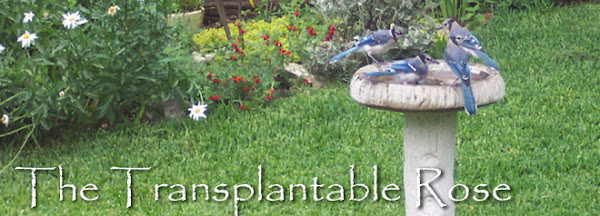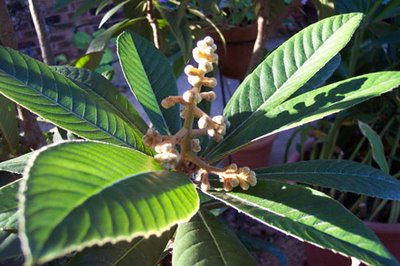
- Annie in Austin
- Welcome! As "Annie in Austin" I blog about gardening in Austin, TX with occasional looks back at our former gardens in Illinois. My husband Philo & I also make videos - some use garden images as background for my original songs, some capture Austin events & sometimes we share videos of birds in our garden. Come talk about gardens, movies, music, genealogy and Austin at the Transplantable Rose and listen to my original songs on YouTube. For an overview read Three Gardens, Twenty Years. Unless noted, these words and photos are my copyrighted work.
Tuesday, December 19, 2006
Annie, Unplugged
Ted’s example inspired me, and soon I had more than half-a-dozen songs under copyright. Together, they tell a story – a sort of musical play. Although the situation - that transplantation from Illinois to Austin - was my own experience, in the story the leading lady is quite a different person, who comes to Austin for very different reasons.
One of the songs is called “The Transplantable Rose”, also used as the name for this blog last June. I’m no singer, but it’s my song, now on YouTube, along with the previously recorded theme for the Divas of the Dirt. Friend Nick recorded the sound, and played the acoustic guitar for “The Transplantable Rose” and Philo made the video.
Station kaefka is a joint effort by Philo & me, [reachable when you double click on the YouTube screen] and 'age 40' refers to how many years we’ve been together. At station kaefka you’ll see links to other favorite videos, including Ted playing his concertina and videos by Ted’s wife, our darling Diane Marie, who is a professional musician in the Chicago area.
When I was nine years old my ambition was to be a writer and a singer – half-a-century later the folks at Google have given me that chance. Thank you.
Monday, December 11, 2006
Enjoying the Evergreens
 According to Google Earth, it’s less than 14 miles from Austin’s Zanthan Garden to my Austin garden, but if you’ve been looking at our garden blog posts, we seem to be at least half a climate zone apart. MSS’s tomatoes are chilled, but intact, having gone just below the freezing point a few times. Another Austin blog, Rantomat, reports nothing frozen at all in her garden. Pam at Digging does seem to have a few frosted plants.
According to Google Earth, it’s less than 14 miles from Austin’s Zanthan Garden to my Austin garden, but if you’ve been looking at our garden blog posts, we seem to be at least half a climate zone apart. MSS’s tomatoes are chilled, but intact, having gone just below the freezing point a few times. Another Austin blog, Rantomat, reports nothing frozen at all in her garden. Pam at Digging does seem to have a few frosted plants. In this NW corner of Austin, my tomato and pepper plants were turned to mush at the first freeze on the first morning of December, with other plants, like the Pineapple Sage [Salvia elegans], not giving up until the temperatures went below 32ºF for a third time.
In this NW corner of Austin, my tomato and pepper plants were turned to mush at the first freeze on the first morning of December, with other plants, like the Pineapple Sage [Salvia elegans], not giving up until the temperatures went below 32ºF for a third time.
The fennel turned brown right away, but the Mexican Mint Marigold was barely brushed by the cold.
The Philippine Violet succumbed after the second freeze, first getting limp, now drying in place.  There’s a paperwhite narcissus in front of it, ready to open a bud. Maybe the plants in South Austin are alive because of the moderating effect of the Colorado River, which has been dammed to make Lake Austin and Town Lake.
There’s a paperwhite narcissus in front of it, ready to open a bud. Maybe the plants in South Austin are alive because of the moderating effect of the Colorado River, which has been dammed to make Lake Austin and Town Lake.
Is that what makes the difference? Or is it just being closer to the heart of the city? Another factor may be variations in elevation – Zanthan lies somewhat less than 500 feet above sea level, while Pam/Digging is under 680, and the elevation for the patio at The Transplantable Rose is 978 feet.
[That’s only 22 feet under the official definition of ‘mountain’ in the sweet Hugh Grant movie, The Englishman Who Went Up a Hill But Came Down a Mountain.]
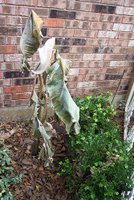 Unlike the gardenblogs of true northern gardeners like Kati, I have no beautiful frost photos to offer, because these cold snaps hit and run, leaving damage but not sticking around to look seasonal. We have few conifers, but our broadleaved types of evergreens take over now, and plants like the boring-in-summer boxwood are appreciated when the banana is hanging in tatters.
Unlike the gardenblogs of true northern gardeners like Kati, I have no beautiful frost photos to offer, because these cold snaps hit and run, leaving damage but not sticking around to look seasonal. We have few conifers, but our broadleaved types of evergreens take over now, and plants like the boring-in-summer boxwood are appreciated when the banana is hanging in tatters.
Flowers like pansies and dianthus are planted in fall, or soon after the holiday decorations come down, and are called winter annuals. 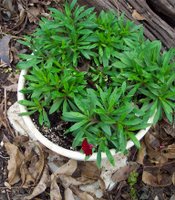
In Illinois we planted them in late April, but that’s when the heat starts here. Dianthus and pansies sail though most winters, unfurling buds on warmish days, enjoying the cooler weather just as the gardeners do.
That’s an Ilex at the tip of this post – a Burford Holly of some kind. This shrub was already here when we came, but has never been so full of berries before. I cut a few pieces from it, stripping the bottoms of the clipped twigs and pushing them into the hanging baskets so that the berried tops will hide what remains of winter-killed lantana plants. I’m hoping the twigs can stay green as long as possible, holding onto their berries, and maybe a few can root, if conditions are right.
 There’s a hedge of these hollies between my house and the one next door. I like my neighbors - they're lovely people - but they're not gardeners in any way. They prune to ensure that no shade falls across their pool, and they think that the outdoors should be as tidy as the indoors.
There’s a hedge of these hollies between my house and the one next door. I like my neighbors - they're lovely people - but they're not gardeners in any way. They prune to ensure that no shade falls across their pool, and they think that the outdoors should be as tidy as the indoors.
I had been eying my side of the hedge earlier in fall, observing the stem ends start to extend in new, lighter-colored growth and the berries begin to turn color. My plan was to make a real holly wreath for my door this Christmas. I was shocked to come home one day and find the Neat-Neighbors had used some kind of hedge clippers to form the holly hedge [and even the graceful variegated privet!] into ugly geometric boxes. If any of those holly cuttings take root, there may be another hedge of holly here some day, not along the lot line, but growing well inside my domain, and never touched by a power tool.
Saturday, December 02, 2006
Decisions Were Made
We used a dolly to roll the yellow plumeria into the garage, where it now fills a corner with 7-feet tall by 4-feet wide branches.
 I started this plumeria from a stick in 2001, and at the beginning of each winter it has dropped its leaves and stayed dormant in the garage.
I started this plumeria from a stick in 2001, and at the beginning of each winter it has dropped its leaves and stayed dormant in the garage.In spring of 2005, a kind NE Austin gardener named Jane gave me a cutting from one of her red plumerias. Once it was well-rooted and repotted, the new one began to grow, reaching 30 inches by late fall 2005, when it joined the bigger one in the garage. But just like my kids, this baby would not go to sleep, refusing to go dormant. Moved outside again in spring, it branched out, bloomed, and grew quickly to over 5-feet tall. This year, I’m trying an experiment, letting the Plumeria stay awake for the winter in the breakfast room.
 We should probably start referring to this space as the conservatory – the Meyer’s Lemon is also inside near the windows. Christopher from Hawaii suggested that we keep this lemon tree as a potted plant, and buy a new one for the ground. This idea made sense to my husband, and with 7 almost-ripe lemons on it along with a new batch of pea-sized fruit, I couldn’t bear to leave it outside!
We should probably start referring to this space as the conservatory – the Meyer’s Lemon is also inside near the windows. Christopher from Hawaii suggested that we keep this lemon tree as a potted plant, and buy a new one for the ground. This idea made sense to my husband, and with 7 almost-ripe lemons on it along with a new batch of pea-sized fruit, I couldn’t bear to leave it outside! On the windowsill in the photo you can see the little Aloe, safe because Pam/Digging warned me it was tender. Last winter, a pink tropical Hibiscus spent the winter in the breakfast room but it wasn't happy, developing both mealybugs and aphids. I set this plant close to the back wall near a window, but won’t let that Hibiscus inside this winter. There was a good spot for the Hedychium coronaria [Hawaiian White Ginger] near the back fence, so a big chunk from the patio container went there, with lots of amendments, a good watering, and leaf mulch piled around the base. The 'Best of Friends' daylily from Pam was planted, too, but the rest of the garden had to be left to chance.
On the windowsill in the photo you can see the little Aloe, safe because Pam/Digging warned me it was tender. Last winter, a pink tropical Hibiscus spent the winter in the breakfast room but it wasn't happy, developing both mealybugs and aphids. I set this plant close to the back wall near a window, but won’t let that Hibiscus inside this winter. There was a good spot for the Hedychium coronaria [Hawaiian White Ginger] near the back fence, so a big chunk from the patio container went there, with lots of amendments, a good watering, and leaf mulch piled around the base. The 'Best of Friends' daylily from Pam was planted, too, but the rest of the garden had to be left to chance. On Thursday three clumps of Bengal Tiger cannas were in bloom, the non-blooming Brugmansia stood a foot taller than it had been in the spring, while the various Cupheas were blooming and still attracting bees and butterflies. A large Fennel plant also offered flowers to the butterflies.
On Thursday three clumps of Bengal Tiger cannas were in bloom, the non-blooming Brugmansia stood a foot taller than it had been in the spring, while the various Cupheas were blooming and still attracting bees and butterflies. A large Fennel plant also offered flowers to the butterflies. 
I was still wearing shorts and sandals on Wednesday, as I finally got my act together, hoping the precautions were not really necessary. Over the last few years we’ve heard many frost or freeze warnings that never actually delivered the expected blow, but this time, the predictions were quite accurate. The Friday landscape showed the changes, with all the canna leaves a tobacco color, the top of the Brugmansia floppy, and both fennel and the cupheas shriveled and browned. I was actually glad to see the peppers and tomatoes wilted by the freeze, and the basil put out of its misery. Cleaning up a big mess is sometimes easier than fidgety maintenance!
Now the Christmas tree is assembled, with lights in place, ready for decorating. We’re enjoying our happy kitchen-conservatory, and thanks to the big freeze, I’m moving forward again.
Tuesday, November 28, 2006
In Transition

Many things have been started – few things have been finished – most things are stuck somewhere in the middle. At the beginning of this year the word I chose as my theme for 2006 was, “Decide” – and now in November it’s time to drag this word out again and repeat it over and over, hoping it can jolt me out of my mental inertia.
It’s been so warm that I didn’t bring the two Plumeria trees inside yet, and still haven’t figured out where I can fit them. After 7 months in the garden, both are in larger pots with much longer branches, so the corner of the garage is going to be really tight. The Hawaiian White Ginger needs to go in the ground, but where? The evergreen Hibiscus used to fit in the kitchen near the window, but it’s doubled in size. Should I prune it severely? Will that kill it? Can the Aloe vera stay out or is it tender? The Meyer’s Lemon is still in the pot by the door, and will probably come in and out for this winter. I’m still not sure where I want to put the daylily from Pam. There are a few peppers left hanging in the vegetable garden, in hopes they’ll be a little bigger by the time the cold cuts them down.
The weather has been pleasant and dry and the leaves are falling – so I'd better water all the containers and whatever’s been recently planted & transplanted. We want to put the Christmas tree up this week, so I'll start to move the furniture from that corner. I need to do some Christmas shopping, but I don't have a car today. Maybe I should write a few cards… but first I’ll answer email. I haven't posted in a week, but first I'll read a few garden blogs. I'll make up my mind after I eat the last bowl of turkey soup.
Then at 3 AM Monday I woke up to the sound of rain hitting the roof, maybe a third of an inch, bringing down another batch of leaves. The prediction now is for possible drizzle, with a few more warm days – then a freeze on Thursday and Friday. So my dithering must end and it’s time to Decide.
 For decades of Thanksgiving feasts and Christmas dinners in Illinois, my mom has made a raw cranberry relish, and we use her recipe here in Texas. You’ve probably tasted it or maybe you make it yourself, with a bag of raw cranberries, a whole orange and a little sugar, chopped fine in a food processor or in batches in a blender. The Meyer's Lemon tree has produced some ripe fruit, with half-a-dozen lemons still to come. This year we made our relish with 2 bags of raw cranberries, 2 Meyer's lemons and one whole Satsuma orange, adding just barely enough raw sugar.
For decades of Thanksgiving feasts and Christmas dinners in Illinois, my mom has made a raw cranberry relish, and we use her recipe here in Texas. You’ve probably tasted it or maybe you make it yourself, with a bag of raw cranberries, a whole orange and a little sugar, chopped fine in a food processor or in batches in a blender. The Meyer's Lemon tree has produced some ripe fruit, with half-a-dozen lemons still to come. This year we made our relish with 2 bags of raw cranberries, 2 Meyer's lemons and one whole Satsuma orange, adding just barely enough raw sugar.  We were amazed at the sparkle and flavor the lemons added to this old favorite.
We were amazed at the sparkle and flavor the lemons added to this old favorite. You see? I couldn’t even decide how to write this post! Should I talk about the relish recipe or whine and ramble about indecision at the end of November?
Both.
Sunday, November 19, 2006
The Essential Earthman

When Carol chose The Essential Earthman for her Garden Bloggers Book Club, I was pretty sure the garden bloggers would enjoy it, but wondered what an average new gardener would think about it. Henry Mitchell started writing his garden columns in the mid-1970’s, around the time that Philo and I bought our first house. Back then, the gardeners we knew might have a basic reference book or two, but were likely to ask friends for advice or use the library to look up plants and their care. Learning how to grow things came with homeownership, stick trees abounded, and the front yards in some neighborhoods became startlingly similar, as neighbors grew and passed around divisions of the same variegated hostas, orange daylilies, phlox and iris.
If you could remember a few botanical names, liked to mail-order unusual plants and were building a collection of garden books, you became known as a ‘plant nut’, and I earned the label while gardening at our second house in the eighties. At some point, I left the ‘how-to’ books on the library shelves, taking home writers like Allen Lacy and Henry Mitchell, whose detailed observation, passion for plants and personal garden philosophy outweighed many tomes of instruction.
Twenty years later, anyone can Google, so no one needs to search through 14 or 15 books to identify a single perennial. News stories tell us that few people will wait for shrubs or trees to grow – they flip the house after a short stay. I read that half the homes in the US use a lawn service - do the owners ever learn the names of what's in their yard? How can gardeners find a personal style of gardening when they learn about gardens from television? Those instant makeover garden shows instill the personality of the TV host, not the owner.
There also seems to be an undercurrent of antagonism in horticulture news – homeowners associations attack native plant advocates, lawn afficianados & and neat freaks square off with organic gardeners, and those newly converted to ecology seldom tend their own gardens, preferring to criticize everyone else’s instead.
It appears that a garden is now an investment; a garden is now a stage on which to display wealth; a garden is now a political battlefield.
 Along comes Carol, sending today's gardeners out to find The Essential Earthman. I cannot imagine Henry Mitchell looking at his lot as real estate – this man inhabits every square inch of his garden! He jams the plants in too closely, grows difficult, exotic plants from all over the world, starts trees from seed, succumbs to zone-envy, takes an entire day to get three tomatoes planted, and is overcome by the beauty of roses and iris. He speaks of the impact of a single marigold in a sea of petunias. He rejoices in small triumphs like one perfect daffodil in bloom, he putters and fusses with his stock tank, gloats over his Chinese bronze dog, and loses track of time. He encourages us not to lose heart as we deal with unpredictable weather, because “It is defiance that makes gardeners”.
Along comes Carol, sending today's gardeners out to find The Essential Earthman. I cannot imagine Henry Mitchell looking at his lot as real estate – this man inhabits every square inch of his garden! He jams the plants in too closely, grows difficult, exotic plants from all over the world, starts trees from seed, succumbs to zone-envy, takes an entire day to get three tomatoes planted, and is overcome by the beauty of roses and iris. He speaks of the impact of a single marigold in a sea of petunias. He rejoices in small triumphs like one perfect daffodil in bloom, he putters and fusses with his stock tank, gloats over his Chinese bronze dog, and loses track of time. He encourages us not to lose heart as we deal with unpredictable weather, because “It is defiance that makes gardeners”.I hope he will be an antidote to these depressing news stories, and that H.M.'s words will be like oxygen for those who still want genuine, experimental, personal, overreaching, messy, ridiculous gardens, not reading the pages on fast-forward, but savoring his thoughts, like this one:
... it is the Spectrum not the color, that makes color worth having, and it is the cycle, not the instant, that makes the day worth living...
Henry warns us, “ Your garden will reveal your self. Do not be terrified by that…”
I pondered those words in June as I clicked ‘Post this blog entry’ for the first time, knowing that once seen, my garden was sure to give me away, revealing my self.
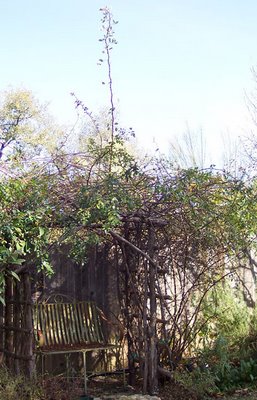
I believe in Henry Mitchell’s kind of garden philosophy. His plant-specific advice, however, was written a quarter-century ago, for gardeners living far from Austin, and being under that influence got me in a bit of trouble here.
By 2000, I’d read and reread H.M.’s description of the wonderful yellow ‘Mermaid’ rose. Deer ate the roses in my own neighborhood, and I couldn’t grow any, but my friend Diane needed a climbing rose for her large new wooden arbor. I talked her into buying a ‘Mermaid’ just so I could see this rose in full glory. Henry did allow that it could be a 'large' rose, but Diane’s plant went way past “Mermaid’-size, way past ‘Manatee’ size, all the way up to Rosa ‘Orca’.
Thursday, November 16, 2006
Read All About It
 On the top of this garden blog there’s a note telling you that I write the Transplantable Rose as Annie in Austin, and the Divas of the Dirt as Glinda. Maybe some of you have looked at the Diva site already?
On the top of this garden blog there’s a note telling you that I write the Transplantable Rose as Annie in Austin, and the Divas of the Dirt as Glinda. Maybe some of you have looked at the Diva site already? The women in our gardening group have had a pretty exciting experience recently – the Austin American Statesman became interested in our story, and featured us in today’s newspaper. The article in the Austin American Statesman is called Digging, Dishing and Derring-Do, written by Julie Bonnin.
To make it even more fun, another Julie, Julie Ardery from the Human Flower Project used that story as the nucleus for her post today. If you’d like to take a look, here’s the link to the Human Flower Project take on the Diva article, with links to the original Statesman article.
If you want even more Diva adventures with photos – there’s now a YouTube with our theme song on the Diva page. I'm going for a few more antacid tablets now - this has been a little stressful!
"We Are The Divas Of The Dirt"
Sunday, November 12, 2006
Mexican Mint Marigold
 This is the Mexican Marigold/Tagetes lucida photo that would not show up in the last post. There's a Lavender behind it, with an old Rosemary plant in bloom in the background. All three of them are in the gravel herb bed, right outside the patio door, and all three have fragrant leaves. Even if you don't cook or make lavender sticks, these herbs are worth growing for the sensual pleasure of brushing your hands across them as you go past, releasing the fragrances.
This is the Mexican Marigold/Tagetes lucida photo that would not show up in the last post. There's a Lavender behind it, with an old Rosemary plant in bloom in the background. All three of them are in the gravel herb bed, right outside the patio door, and all three have fragrant leaves. Even if you don't cook or make lavender sticks, these herbs are worth growing for the sensual pleasure of brushing your hands across them as you go past, releasing the fragrances.Hallelujah - now I can go to bed.
Saturday, November 11, 2006
Wish for a Walk
 The soldier in the photo is my dad, still recuperating from the malaria he contracted in the South Pacific during World War II. A few months after he was sent back to the US, my Mom took the train from Chicago to Virginia for their wartime wedding, along with two of her sisters and my dad's baby sister - that's one of my aunts on the left.
The soldier in the photo is my dad, still recuperating from the malaria he contracted in the South Pacific during World War II. A few months after he was sent back to the US, my Mom took the train from Chicago to Virginia for their wartime wedding, along with two of her sisters and my dad's baby sister - that's one of my aunts on the left. November 11th was a good day to remember my father, because he was a veteran, and to remember my aunt, because November 11th was her birthday – the day was known as “Peace Day” back in the twenties when she was born. I talked to my mom earlier today and she thinks that the flowers in my aunt’s hand were Sweetpeas.
If my dad were alive and here at my house, and if my aunt were alive and came for a visit, we'd all be taking a garden walk together, because they were gardeners, too. I can’t take them on a November tour, but I can take you.
 The leaves of the hardy white Hibiscus moscheutos ‘Blue River II’ are one of the few things in the garden that have changed to a yellow autumn color. The Salvia elegans/ Pineapple sage is at its reddest, and the Salvia guaranitica is at its bluest at this time of year.
The leaves of the hardy white Hibiscus moscheutos ‘Blue River II’ are one of the few things in the garden that have changed to a yellow autumn color. The Salvia elegans/ Pineapple sage is at its reddest, and the Salvia guaranitica is at its bluest at this time of year. If Blogger would be ever work right, there'd be a photo of Mexican Marigold/Tagetes lucida right here. Mexican Marigold doesn’t bloom until late fall, and the Rosemary is also blooming right now. Mexican mint marigold leaves can be used to give a tarragon flavor in cooking, helpful in Central Texas where tarragon is almost impossible to grow. Whether I cook with them or not, the color is just right for November.
The Snail Vine/Phaseolous caracalla has been a solid performer since spring.

It's been covered in flowers during summer, and is still making buds and blooms today, but in all those months, I’ve never seen a seed pod.
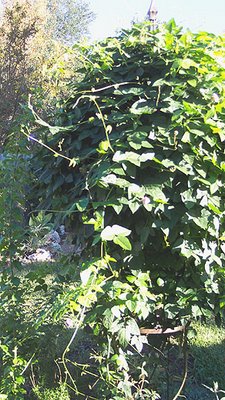 This vine has completely engulfed the obelisk, needing frequent clipping – it's been two weeks since the last clean-up, and the vine is sending long tendrils in every direction, reaching out all over the bed, trying to strangle the Duranta erecta/Skyflower.
This vine has completely engulfed the obelisk, needing frequent clipping – it's been two weeks since the last clean-up, and the vine is sending long tendrils in every direction, reaching out all over the bed, trying to strangle the Duranta erecta/Skyflower.The rampant nature of the snail vine makes me think I’d rather put something else on the obelisk next spring. The vegetation is very densely packed, forming into a huge blob toward the top that casts too much shade on the other plants, as if it's trying to shade out whatever it hasn’t been able to choke to death. Snail vine is not supposed to be hardy, so I probably won’t have to evict it, just let winter edit this part of the garden. Perhaps I'll let the Moon Vine grow on this obelisk next year, so the flowers can rise higher that the fence, and will have four sides on which to flaunt those fragrant white flowers, instead of the flat, 6-foot fence.
There are signs of autumn here, but they’re quite different from the gold and red leave
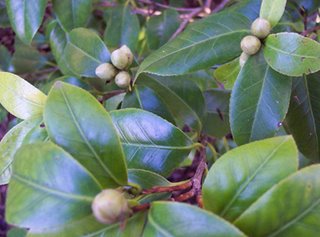 s of the North.
s of the North. I know it’s fall when my Camellia japonica ‘Pius IX’ starts swelling round buds all over the branches.
There’s a Sasanqua camellia in the garden, too, but it didn’t like the weather last summer and is sulking this fall, without a single bud. The japonica has had full years and sparse years, but ever since I bought it in the autumn of 2001, each winter there have been flowers.
The other signal that autumn has arrived is a tree in bud, and I so wish my dad and aunt could have seen this one.
It’s the lovely Loquat tree, [Eriobotrya japonica] stretching out long panicles of flower buds, which will open in a few weeks, sending their fragrance all over the garden.
Sunday, November 05, 2006
Not Zanthan's Mystery Weed
Check out the Mystery Weed photos and comments at Zanthan Gardens, [linked at left]… she’s received an identification on her mysterious, tradescantia-family plant via Valerie at Larvalbug, [linked at left], but my plants are not quite the same. Both small, jointed, green, ground covers have larger leaves than Zanthan's ¾ inch Callisia repens exhibits.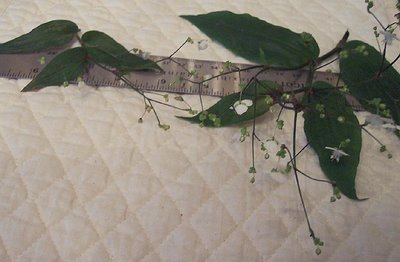
Here are the two green-leaved ones that grow here, with a ruler for scale. I think the smaller-leaved plant at the left side might be the Tradescantia fluminensis suggested by Julie from the Human Flower Project, [linked at left], since the leaves are in the 1 ½ to 2-inch range. This plant was already growing here when we came, possibly rooted from sections that fell from a hanging basket.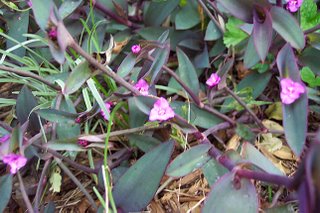
The mysterious tradescantia-looking plant on the right side of the ruler has even larger leaves, between 3 to 4 inches. The leaves don’t have the succulent feel of some houseplants called Wandering Jew, or like the Purple setcreasea at left, which also grows in my garden – the leaves of the larger green plant are almost papery.
The green mystery plant was growing as a groundcover in the garden of one of the Divas.  I rooted some several years ago, and they grew in a hanging basket on the covered porch. The coco liner was disintegrating when we moved here, so I sort of flipped the whole thing out into my new woodland area, the Divas of the Dirt project for October 2004, just leaving it on top of the soil. The little colony quickly rooted and has been very happy in this shady area - seeing them at this time of year makes me happy, too.
I rooted some several years ago, and they grew in a hanging basket on the covered porch. The coco liner was disintegrating when we moved here, so I sort of flipped the whole thing out into my new woodland area, the Divas of the Dirt project for October 2004, just leaving it on top of the soil. The little colony quickly rooted and has been very happy in this shady area - seeing them at this time of year makes me happy, too.
The flowers are appropriately scaled somewhat larger than the possible T. fluminensis. They’re such darling little flowers, but my point-and-shoot can’t show this. [It also can’t take photos of bees on flowers – many failed attempts have proven this!] Whatever the name, this plant has lived through heat, drought and some freezes, with minimal watering and attention. The flowers are even useful when I make an arrangement on a needle frog, adding greenery and some delicate misty white to whatever else I can find in bloom in my garden.
Monday, October 30, 2006
Directed by Duplass
Early last week I got an email, inviting us to be extras for a movie being filmed by Jay & Mark Duplass. As soon I saw who the filmmakers were, I emailed back a definite 'yes', asking that both Philo & I be put on the list. We liked the Duplass brothers’ last movie very much. It was one of two movies I talked about in my June 21st post if you want to check the archives.

Back then I said that this ”…combination road picture/relationship movie is called The Puffy Chair. Jay and Mark, the Duplass brothers, some-time-Austin residents, made the film on an incredibly small budget using many ways to keep costs down: one brother is the director and cameraman, the other stars and acts as producer, family members were talked into giving financial support and taking roles as actors, the homes of family & friends are used as sets, and the number of takes was kept short.
The performances are a delight, and we want to see these people again. Rhett Wilkins is making a habit of playing quirky brothers, since he is the main character’s nature-boy brother in this movie, and the main character’s older brother in Jumping Off Bridges. There are parts of this movie that leave you limp from laughing.
The Duplass Brothers were present at our showing of the movie, and they are hilarious and articulate in person. Mark Duplass has an intense and expressive look, reminding me somehow of Martin Landau when he was very young. Back in 1959, Landau had to be the villain in North By Northwest, but Mark gets to be the lead in a world that better appreciates interesting faces.”
You can read more about the movie at the Official Site. This October, after screenings at festivals and some theaters, The Puffy Chair became available on DVD through Netflix. Now even if you live where access to independent films is limited, you have a chance to enjoy this movie.
Last weekend we went to the filming site for the new project, and found out that many of the other people were experienced at being extras. There were some professional film actors in the group, as well as a local stage actress. We heard about their previous movie work and noticed that some extras brought additional articles of clothing and reading material. All we brought was a tin of Altoids.
It won’t be giving anything away if I tell you that we extras portrayed members of an audience in a movie theater – that’s already been in the movie blogs.
It won’t be giving anything away to say how fascinating it was to watch Jay & Mark and their cast & crew in action.
I’ll only give away my one, tiny ‘extra’ moment which happened during a brainstorming session about one line of dialogue. I made a very audible wisecrack, causing Jay Duplass to look up, smile and say “That’s really funny!” Then he laughed. I found it very cool to make a movie director laugh, especially since he’s the same age as my kids.
 Twenty-two years ago we had a big party, and I dressed as Magenta from the Rocky Horror Picture Show. For 2006, this hat and official Puffy Chair T-shirt will be my costume!
Twenty-two years ago we had a big party, and I dressed as Magenta from the Rocky Horror Picture Show. For 2006, this hat and official Puffy Chair T-shirt will be my costume!Happy Halloween!
EDITED JUNE 15, 2008
We didn't know what the movie title would be back when we were extras in October 2006, but the Duplass brothers named their horror/relationship comedy Baghead. It played Sundance and is now premiering in Austin (playing at the Regal Arbor and at the Alamo Drafthouse) even before it opens on East and West coasts. Philo and I saw the movie (yes, we are visible!) and I'll be posting about it soon.
Saturday, October 28, 2006
Destiny or Delusion?
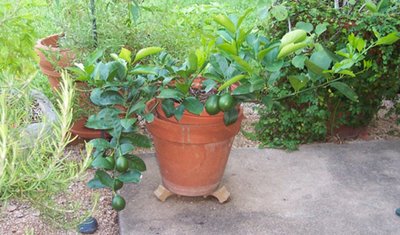 In March I read about a Meyer’s Lemon tree in bloom at Zanthan Gardens, learning that MSS brought it inside only in the coldest winter, and that the butterfly-magnet blossoms smelled really good. This description intensified my desire to grow a Lemon tree, but I thought they were too expensive and didn’t actively search for one.
In March I read about a Meyer’s Lemon tree in bloom at Zanthan Gardens, learning that MSS brought it inside only in the coldest winter, and that the butterfly-magnet blossoms smelled really good. This description intensified my desire to grow a Lemon tree, but I thought they were too expensive and didn’t actively search for one. In April, Philo was looking for lumber, and I was bored and looking for trouble, tagging along to the big box store, cruising the garden section as I entered the building. It must have been Destiny when I stopped in front of a batch of newly unpacked little trees. These trees were small, “produced in Texas”, and labeled “Improved Meyer’s Lemon. They were tagged at only $14.88 so owning this lemon tree was affordable. In addition to the lure of the beautiful glossy foliage, there were even a few tiny lemons developing on one branch, proving that this particular tree had borne flowers.
We put the pot on the patio near the Rosemary where we could see it from the breakfast room, watching the tiny lemons grow slowly, so that by June they looked like medium size limes. There were also a few more blossoms, creamy and fragrant.
It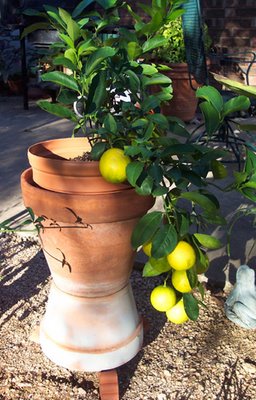 ’s nearing November now and my baby tree has held onto most of the fruit, even through the drought. The lemons are now turning yellow.
’s nearing November now and my baby tree has held onto most of the fruit, even through the drought. The lemons are now turning yellow.
This little tree pleases me whenever I look at it, and whether or not the fruit turn out to be as delicious as the tag promised, they’re beautiful.
I should now be thinking of a place inside my house where the Lemon can get light all winter, but since last Saturday I’ve been envisioning a different future for my tree.
Over at Digging, Pam has been posting a photo journal of last Saturday’s Garden Conservancy tour. Philo & I went to several of the gardens, including that of Deborah Hornickel. Deborah’s garden is wonderful and dramatic, with interesting plants and great design – she was featured in a recent issue of Cottage Living Magazine. If you go over to Pam/Digging's Post you’ll see Deborah’s huge Meyer’s Lemon tree, planted outside, sheltered by the southwest-facing wall of her house. The lemons are enormous! Deborah told me that hers was just a small plant similar in size to mine when she took a chance and set it into the ground 5 years ago.
I really want to try this! Although it’s not exactly a blank area, there’s a perfect spot on a Southwest-facing wall at the back of our house. A large Nandina that was planted by one of the previous owners is there now, and we neither like nor dislike this Nandina – it just came with the house. Luckily for me, Philo was quite taken with the lemon at Deborah’s house, too, and he’s willing to oust the Nandina so we can plant our Meyer’s Lemon tree there. There’s an overhanging eave for ice protection, and it’s close to the back door – increasing the chances that we won’t forget to water it, and can quickly cover it with a blanket on a cold night.
A new batch of blossoms opened last week and are now turning into another set of tiny fruit, which will need months of sun and water to turn into juicy globes. I don't know what will happen if they get too cold and I don't know if the lemon could come back from the roots if we have a mini-ice age in Austin. But I’m ready to take a $15 chance on something wonderful. Do you think this plan is crazy, or would you also plant the Meyer's Lemon outside?
Friday, October 20, 2006
The Continuing Evolution of the Patio
 This is not a How-to-do-it post – more a What-we-did story.
This is not a How-to-do-it post – more a What-we-did story. The patio looked like this when our realtor showed us the house – it was the usual 20’ X 12’ poured concrete rectangle, possibly installed by the builder in the 1970’s. A sidewalk starts at the patio and passes in front of the breakfast room window on its way to the gate. A door from the house opens onto the patio. We were pleased to see that we could fit the table & chairs and the grill on the concrete, with room left for a few pots.
A few pots? We moved here with over 100 container plants in the summer of 2004, carried from the deck and porch of our previous home. Some of them were supposed to be patio plants but most of them belonged in borders and beds. Since we hadn’t yet made the borders and beds, the patio was wall-to-wall with furniture and terra cotta, genuine and faux, overflowing onto the grass.

We had perennials: clematis, heirloom daylilies, agaves, hibiscus, balloon flowers and Amarcrinums. We had tender plants that moved inside for the winter like the Plumeria. We needed a place near the kitchen for the burgeoning herb and hypertufa collection.
A forest of young trees and shrubs had started out as one-gallon starter plants but many were approaching landscape size: one Southern Wax Myrtle, a Camellia japonica, a 4-foot Osmanthus fragrans/Tea Olive, two ‘Celeste’ Figs, an heirloom Philadelphus/Mock orange, a couple of Boxwoods, a large double-yellow Nerium oleander, a Callicarpa Americana/Beautyberry, a Lady Banks Rose, yards of Carolina Jessamine/Gelsemium sempervirens, a little Vitex, two Lagerstroemia/’Acoma’ crepe myrtles and 6-feet of Loquat/Eriobotrya japonica. We also had a tall metal arch that could work for the long side of the patio.
The front panes of the breakfast room window looked across the lawn to an old metal shed, smothered in Hall’s honeysuckle. Seedling crepe myrtles grew against one side pane of the breakfast window, with the sidewalk and grass below. All this had to go - we wanted to see flowers, herbs, birds, bees and butterflies.

As the first winter approached, I planned my long border, dollying pots with selected plants to their future positions along the back fence. I crammed the remaining pots together right up to the edge of the patio, hung the plants with mini-lights and called it our Bistro.
While I puttered around, Philo measured and planned. He had figured out how to enlarge the patio, not by pouring concrete but by using a gravel-type product called decomposed granite, a technique we’d seen on tours of well-known Austin gardens.
His plan was to delineate an area adjoining the perimeter of the concrete, remove the grass and dig out 6 - 8 inches of soil. Philo would use edging to contain the area, we’d replace the soil with one layer of pea gravel, then top it with several layers of decomposed granite totaling 4” in depth, packing each layer in turn. In this way we could keep the furniture and foot traffic on the concrete surface, while using the gravel pads as transitional areas where container plants could meld the patio to lawn and garden.
 The first gravel bed was a test. In spring 2005 we made an 8-foot quarter-circle on the sunny end, fitting it between patio and sidewalk, so that the rosemary and herb troughs could be seen from the breakfast table. We bought the gravel and granite from a nearby organic materials dealer, shoveling them into reusable 5-gallon bags, and loaded the car with 8 or 10 at a time. The herb bed worked well, drained perfectly and looked good all summer.
The first gravel bed was a test. In spring 2005 we made an 8-foot quarter-circle on the sunny end, fitting it between patio and sidewalk, so that the rosemary and herb troughs could be seen from the breakfast table. We bought the gravel and granite from a nearby organic materials dealer, shoveling them into reusable 5-gallon bags, and loaded the car with 8 or 10 at a time. The herb bed worked well, drained perfectly and looked good all summer.
When fall arrived, we added a second quarter-circle on the opposite end, where it could function both as a walkway to the far end of the yard, and as a place for semi-shade plants. Earlier in 2005, we’d taken the Loquat out of its pot and planted this broadleaf evergreen tree near the far end. In time, it should add shade and privacy.
We started work on the next stage in March 2006, when Philo decided to add a two-foot band across the front edge of the patio. He set the edging and we began to dig, sure that this amount of space would be enough.
The metal arch was set into the decomposed granite, a large precast concrete square was set in front of the arch and large containers were placed on each side. I bought our Lady Banks Rose in 2000, bumping it up to a larger container every year. That’s Lady Banks in bloom on the left side of the arch. This spring I bought a native Coral Honeysuckle/Lonicera sempervirens for the pot on the right. The honeysuckle was very small, and I wanted some scent so I added a second small plant, labeled fragrant Corkscrew vine. I figured they’d be okay together.

Wrong! Although it looked good at first, the non-fragrant vine, now recognized as a Snail Vine, tried to murder the honeysuckle. Another Snail vine was thriving elsewhere, so this one was expendable. After I cut the Snail down to a clump & potted it for adoption, DivaAnnie, who liked its flowers, let it come to her garden. Philo added two more precast squares to make an entrance walk, the rose and honeysuckle did reasonably well, and an annual Cypress Vine was accepted by the main characters for the rest of the summer. But something looked wrong - the shapes of the pots and the arch resembled security barriers guarding an entrance.
Last week we added more gravel to make a curving sort of apron for the arch and took the honeysuckle and rose out of their containers, planting them directly into the ground. The whole area was mulched with the decomposed granite.

So far, it seems to work. The patio looks less blocky with the arch moved forward, no longer in line with the large containers along the front edge. I like the way the vine shapes join the trellis nearer to ground level rather than at the top of the containers. Both the Lady Banks rose and the Coral honeysuckle had minor damage from the move, but they’re recovering, and should do well.

Now I can rework the large patio containers, make better combinations, and transplant more of the plants into the beds and borders. Having a transitional area can be handy as plants grow and change! The Loquat is already making the far end shadier, but we’ll have options, because the gravel areas are mutable and the containers are moveable.

About the frequently used ‘we’ in these posts… it’s not an Editorial 'We' or a Royal 'We'. No other word seems to work for a couple with years of experience in working together on house & garden projects. In this case, it’s Philo who swings the mattock to break up rock layers, and does most of the heavy digging, the heavy thinking, and puts in the edges. I help to fill and haul the granite at the U-Dig place & do most of the plant wrangling and planting. I also do a pretty good imitation of Lucy stomping the grapes to compact the layers of gravel.
Saturday, October 14, 2006
TreeFolks
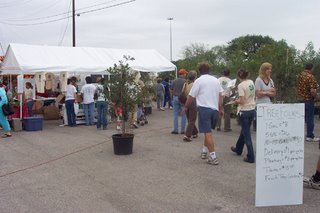 or the Farmers Market.
or the Farmers Market.The Austin organization called TreeFolks began in 1989 and today, "TreeFolks grows the urban forest of Central Texas through tree planting, education and community partnerships."
The group held their first ever benefit tree sale today at the Sunset Valley Farmers Market. There were all kinds of trees available, and a large crowd took home new additions for their own part of the urban forest. The Treefolks even offered delivery and planting services!
My friend Shanda was part of the sale crew – here she checks out some of the fruit trees. Shanda is a member of Treefolks, and also one of the Divas of the Dirt. After some consideration, we bought a Texas redbud for a spot that needs a hardy native ornamental.

 Live music is part of the Market, too. Jimmy Natoli is frequently seen and heard, but today there was a group of young violinists sending their music aloft. I hope TreeFolks did well with their sale!
Live music is part of the Market, too. Jimmy Natoli is frequently seen and heard, but today there was a group of young violinists sending their music aloft. I hope TreeFolks did well with their sale!
Friday, October 13, 2006
CALLING GARDEN PRODIGY
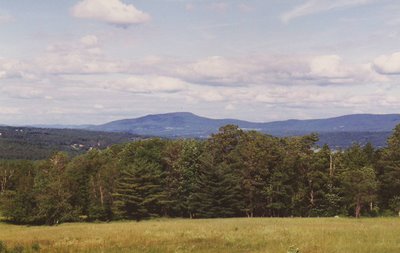
When you look at this photo the conifers might tell you that it wasn’t taken in Texas – in fact it wasn’t taken in this century. A woman named Pam snapped the shutter in June of 1993, as she looked out on the Vermont countryside from the Tearoom of the VonTrapp estate. Pam was part of a group of gardening friends who were touring New England, but not as part of a garden club or a horticulture class. Back in those pre-blogging days, they’d all met on the Prodigy garden bulletin board, where they found soulmates – other people who were obsessed with perennials, bulbs, flowering shrubs and creating personal landscapes.
 The Prodigy gardeners went to Readsboro, Vermont where these Hostas graced the grounds of North Hill. Garden authors and partners Joe Eck and Wayne Winterrowd started this garden in 1977 and thirty years later, they’re still holding open days for groups and fundraisers.
The Prodigy gardeners went to Readsboro, Vermont where these Hostas graced the grounds of North Hill. Garden authors and partners Joe Eck and Wayne Winterrowd started this garden in 1977 and thirty years later, they’re still holding open days for groups and fundraisers.I was one of those long ago perennial maniacs, going online as Kat in N-IL whenever I had time to spare. Despite having only plain text to express our thoughts, slow response times, single phone lines with dial-up, and no way to post a photo or a drawing, it was addictive and exhilarating. Since I couldn’t meet with the others in New England, the garden at North Hill and the Von Trapp estate came to me in photos sent around the country after the trip.
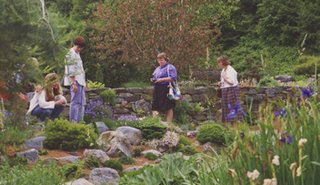
This is also from Vermont - I think it's at Cady's Falls Nursery in Stowe. We never met in person so I can’t even put names to the faces, but loved their words and wonder where they are and if any of them are now garden bloggers, too.
Shout out to all you Gardeners from the Prodigy bulletin boards – Niko in Norwalk, Connecticut, Allen in Linwood, New Jersey, Marion from Waterbury, Vermont, Denise in Minnesota, Ellen & Deb from Illinois, Margaret in New York, Pam in Mechanicsburg, Pennsylvania, Bargyla in San Diego, California, Don from Saginaw, Michigan, Joyce in South Carolina, Nancy from Norcross, Georgia and all the others - I hope you’re still in the garden!
Saturday, October 07, 2006
Full Moon in October
 A few days ago I picked up the camera, and tried to catch the Moonvine Flowers gleaming in the light of an almost-full moon. They’ve been blooming off and on since July, entwined with a Clitoria ternatea/ Blue Pea Vine.
A few days ago I picked up the camera, and tried to catch the Moonvine Flowers gleaming in the light of an almost-full moon. They’ve been blooming off and on since July, entwined with a Clitoria ternatea/ Blue Pea Vine.While trying to take a photo of the Moonvine, something fluttered in front of me – an adult Sphinx moth. I used the flash, and caught him at work. The eyes look pink in the photo, and that’s how they looked in real life.

Last April, before my debut as a garden blogger, I’d taken photos of a White Sphinx Moth caterpillar on my Gaura. Pam/Digging posted a photo of her Sphinx caterpillar around the same time, a sort of bonding experience – for me, anyway!
I wonder how many generations of White-lined Sphinx moths have followed since April?
 The Moonvines had followed the support wires, and one tendril had reached up to climb into the neighbors’ pink crepe myrtle, opening a flower 9-feet in the air… in the dark it looked suspended rather than supported.
The Moonvines had followed the support wires, and one tendril had reached up to climb into the neighbors’ pink crepe myrtle, opening a flower 9-feet in the air… in the dark it looked suspended rather than supported.I was awake late last night, and at 2 AM, decided to go on the patio to stand under the full moon.
The October moon is usually the Hunter’s Moon, and some towns, like West Lafayette, Indiana, are holding Hunter’s Moon Festivals this weekend.
But according to the Farmer's Almanac, the date of last night’s full moon was closer to the equinox than the date for the September moon, making the October moon the Full Harvest Moon, with the Hunter’s Moon still to come in November.
I opened the patio door and walked out, loving the way that moonlight can make shadows, sure that I could actually see in colors. Ten yards to my left the white discs of the Moonvines hung on the fence. As I turned toward the fence, something low and round came barreling out of the dark corner of the fence corner straight at me – just as my brain said, ‘neighbor’s cat’, the head came up, we locked eyes and I saw the mask. I stood still, and stared back - the raccoon decided to rotate and run, climbing the fence and disappearing in a couple of seconds. He may have known it was the Harvest Moon, but wasn’t sure whether I was celebrating the Hunter’s.
